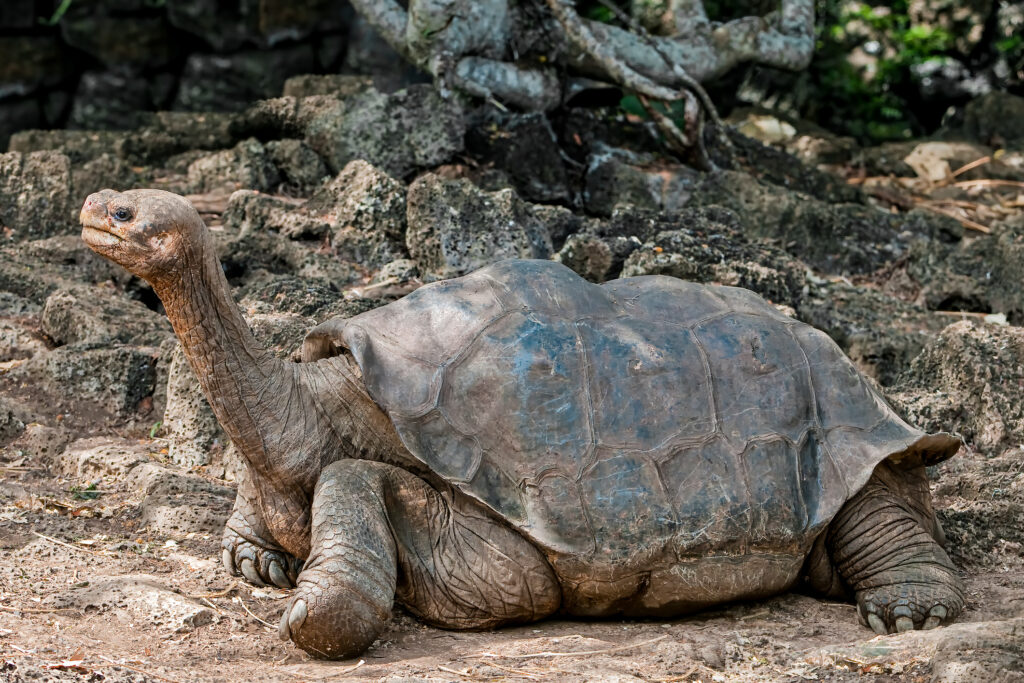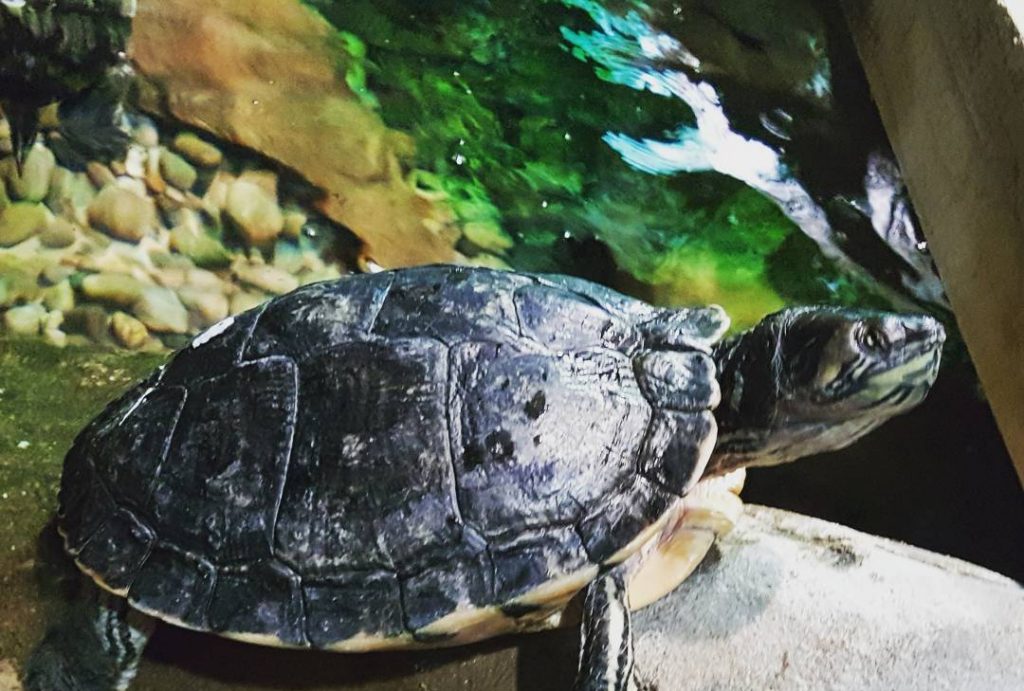Tortoises are among the most fascinating-looking creatures on the planet, with their large shells being an iconic aspect of their physiology. It’s not just their shells that make them fascinating though – there’s a lot more than meets the eye for these creatures who are spread throughout the world.
Together, we’re going to explore some must-know facts about tortoises so that you can share this knowledge with family and friends during your next visit to Tynemouth Aquarium.
What’s the difference between a tortoise and a turtle?

Despite being very similar-looking animals and often being mistaken for one another, there are key differences between the two animals. It’s also worth pointing out that while all tortoises can be classified as turtles, not all turtles are tortoises, which we’ll explain later in this blog. For now, though, here are a few of the major differences.
Habitat
If you’re on land and spot a four-legged, shelled creature, it is a tortoise. What people typically refer to as a turtle, you will only find in bodies of water.
Shell
Turtles that live in the sea must be streamlined to glide through the water. Tortoises don’t have this issue and don’t move quickly enough to worry about aerodynamics, so they typically have larger, heavier shells.
Flippers
To swim through the sea effectively, water-dwelling turtles have flat, broad flippers to propel themselves through the water. Land-dwelling tortoises will have bulkier, thicker legs allowing them to support their heavier weight.
9 must know facts!
Let’s dive straight into the facts that make these incredible animals so unique! From habitat to lifespan, tortoises truly are remarkable creatures.
Tortoises are reptiles
Reptiles are a hugely diverse classification of animals, including the likes of snakes, geckos and tortoises. Despite being vastly different animals, they all fall under the same umbrella classification.
Reptiles are characterised by having a backbone, laying eggs, usually between 4 and 8, but sometimes 50 or more, and having scales. This is why a snake and a tortoise can be classified in the same group.
Tortoises are turtles, but not all turtles are tortoises
In terms of classification, all tortoises are turtles but not all turtles are tortoises. Confused? Allow us to explain.
This is because tortoises started in water and have gradually moved onto land without straying far enough genetically to be classified as an entirely different species. In essence, tortoises are just land turtles.
Turtles are separated into two main suborders, Pleurodira and Cryptodira, which differ mainly in the way that their heads retract.
Tortoises have shells for protection
One of the key characteristics of turtles is their shells! These functional, yet beautiful, shells are made of bone and cartilage. The shell is comprised of two parts; the top of the shell is called a carapace, and the bottom is called a plastron.
The shells are designed primarily for protection, making a typically slow-moving animal awkward and difficult to kill or eat when they retreat into it when threatened.
Not only does the shell act as fantastic protection, but it also helps to absorb heat which is vital for cold-blooded turtles.
Tortoises can’t swim
Unlike their sea-bearing cousins, the land-dwelling tortoise cannot swim. Over millions of years, tortoises have evolved to survive on land, giving them a stocky build that isn’t ideal for life underwater. They will enter water solely to drink and bathe.
Turtles, on the other hand, are incredible swimmers, with streamlined shells and flat, wide flippers that help them to reach speeds of up to 22 miles per hour for large species such as the leatherback turtle. Usually, turtles are fairly relaxed creatures, preferring a calmer 5-mile-per-hour cruise when they aren’t under threat.
Tortoises have been on planet Earth for over 220 million years
Archaeologists have found evidence to suggest that turtles date back to the Triassic period, about 230 million years ago! This makes them an incredibly old species in the history of the world.
Tortoises are one of the longest-living animals in the world
Tortoises are renowned for their fantastically long life, with some examples living well over 100 years. Not every turtle will live to that grand old age though, with some species only living for 10-20 years in captivity.
Across all species, approximately 50 years is about the average lifespan of a tortoise.
Interestingly, the sexual maturity of tortoises isn’t decided by age, but by their size. If they’re big enough to mate, their age isn’t usually a factor.
Tortoises live all around the world

Tortoises, as a species, are incredibly diverse and well-travelled. They can be found on every continent except Oceania and Antarctica.
Tortoises have adapted remarkably to a range of habitats from deserts all the way to tropical rainforests, with each species possessing differences that allow them to thrive in a specific ecosystem. For example, tortoises that live in the rainforest tend to have soft skin rather than the scaly skin you may see on tortoises that live in arid environments.
The largest tortoise in the world is the Galápagos Tortoise
The largest, and possibly most famous, tortoise in the world is the Galapagos Tortoise (Chelonoidis niger). Incredibly, as well as being the largest, it is also known to be one of the longest-living, with a maximum life span of up over 150 years in captivity.
This large tortoise is recognisable by its large, domed shell and thick, sturdy legs to support their enormous weight. Weight within the species can vary but on average, they weigh approximately 250kg, with males weighing significantly more due to their enormous size.
They are so unanimous with the Galapagos Islands that the islands are actually named after them, with Galapagos being an old Spanish word for tortoise.
The smallest tortoise in the world is the Speckled Tortoise
The adorable and tiny speckled tortoise (Chersobius signatus) is the smallest of the tortoise species. Native to southern Africa, these tortoises can be found in South Africa, Namibia, Botswana, and Zimbabwe.
On the complete other end of the scales, the speckled tortoise doesn’t even weigh as much as a bag of sugar, with an average weight of between 95-120g.
These animals are under constant threat from poachers looking to sell the speckled tortoise in the pet trade, which is why the sale of these tortoises is illegal in South Africa and Namibia.
Quick-fire facts!
· Tortoises are most active during the day
· They (mostly) eat plants, vegetables and grass
· There are almost 50 species of tortoises
· A group of tortoises are called a creep
Meet our Red-footed tortoise
At Tynemouth Aquarium, we’re proud to have our very own red-footed tortoise (Chelonoidis carbonaria)! They’re only small tortoises but they’re incredibly beautiful with distinct red markings on their head and feet.
They’re native to South America and the Caribbean, being comfortable in both wet and dry environments such as rainforests but also grasslands and savannas. Living for up to 50 years, these tortoises cope very well in captivity, making remarkable pets for those with the knowledge and time to care for them.
At Tynemouth, you can find the red-footed tortoise in the Amazing Amazon exhibit, where we replicate the warm, humid climate of a rainforest environment.
Turtles, from the largest Galapagos tortoise to the tiniest speckled tortoise, are all incredible creatures with an incredible history of adapting to a wide range of environments. Whether they’re gliding through the ocean or waddling through the desert, they fit right in and demonstrate the wonder of natural diversity.
If you’d like to say hello to our red-footed tortoise, then don’t hesitate to book your tickets to Tynemouth Aquarium and make sure to remember all the incredible facts we’ve provided you with to teach your family and friends!
